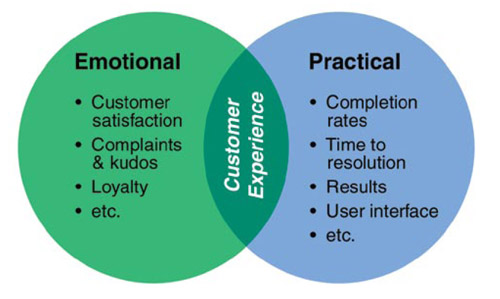|
October 2008 | Volume 11 / Number 10
Viewpoint: Voice of the Customer
Measuring The Customer Experience
Most of the time when I ask people how they measure customer experience, they talk about customer satisfaction surveys. Okay, that’s part of it, but they’re missing a lot of other information that provides a complete picture of what your customers experience when they deal with your company. Put yourself in your customers’ shoesOne key task is to try to accomplish common tasks — what is the customer experience at some key moments of truth? For example, if you work for an airline, make a reservation, check in for your flight, and actually take the flight. Try a number of different channels. Where is the experience positive and where is it lacking? Think like a passenger — is the check-in experience easy and intuitive, are agents and others friendly and helpful, is the flight comfortable? Map each experience and list all the satisfiers and the dissatisfiers. Building these customer experience maps helps you understand pain points as well as where you’re doing well. Take the satisfiers and dissatisfiers and score the experience. You can score the total experience, experience by channel, or by customer segment. Weight each element based on your customer interaction strategy. Consider criteria like branding, channel consistency, ease of use, or efficiency. Other MeasuresWhat else should you measure? Two kinds of measures make up the customer experience: emotional and practical. Emotional MeasuresThere are lots of ways to gain insight into what your customers are feeling, including:
Practical MeasuresFocus on indicators of customer success across all channels in order to understand:
Most people gather these metrics on the contact center side, but few track them across channels. Some key measures include:
Yes, it sounds like a lot of work, but customer experience has enterprise-wide implications for how customers perceive your company and where you can improve that perception. I suggest that you develop a report card with some of your strategic measures, create a baseline, and identify all changes and benefits. Track and assign real value to improvements. That way you can understand how a better customer experience helps make more money, save money or avoid costs. Elaine Cascio is a Vice President at Vanguard Communications Corporation, a consulting firm that specializes in contact center processes, operations and technology. She heads Vanguard’s self service practice. Visit www.vanguard.net or contact Elaine at [email protected]. Today @ TMC
Headlines
Upcoming Events
MSPWorld
The World's Premier Managed Services and Cloud Computing Event Click for Dates and Locations Corporate News
|
|





 If you’re like me, you run across white papers and articles every day that talk about how you can improve the customer experience. And while many have good concepts and ideas, none of them really talk about how you know when you’ve created an excellent customer experience.
If you’re like me, you run across white papers and articles every day that talk about how you can improve the customer experience. And while many have good concepts and ideas, none of them really talk about how you know when you’ve created an excellent customer experience.

